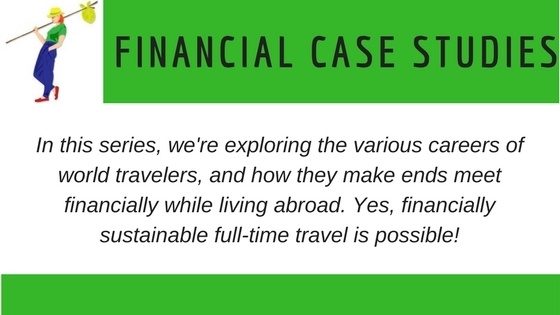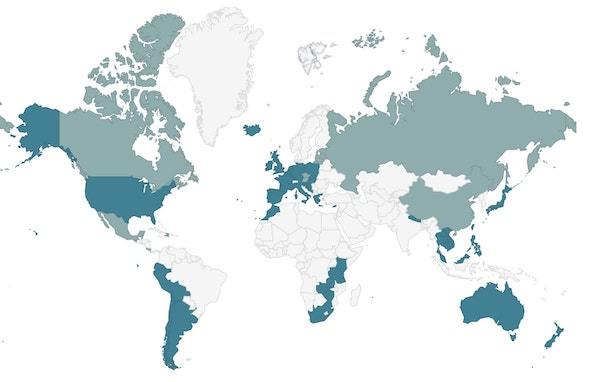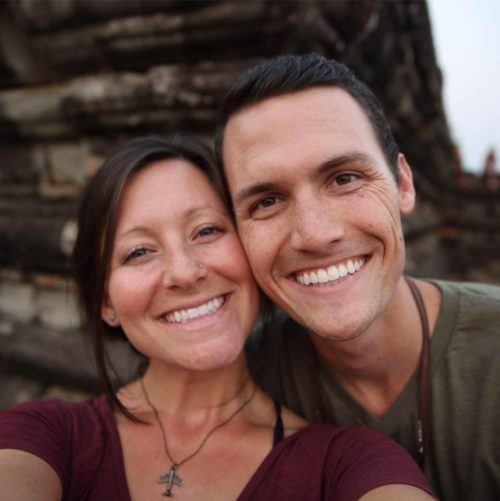Kara and Nate Buchanan are husband and wife, and full-time travel YouTubers on a mission to visit 100 countries by 2019. They’re currently in country #66. You can follow their daily adventures on their YouTube channel, or if you want to learn about their finances and other travel tips you can check out their website Kara and Nate.
I’ve been nurturing my own YouTube channel for years, but Kara and Nate have it down to a science. Check out how they use it to earn a full-time travel living!

Want to learn how to travel (long-term or full-time) in a financially sustainable way yourself? Sign up for my FREE 2-week email course here to learn everything you need to know!
This post was originally published in 2017. It has since been updated for accuracy of links and content.
How long have you been living/working on the road, and where have you traveled to?
We started traveling full-time in January of 2016. We’ve now been to 66 countries on six different continents. I think the easiest way to tell you where we’ve been is to show you.

Please describe what you do for income.
The last two years have been a massive experiment to develop enough sources of income to keep us on the road full-time. We’ve tried a lot of things over the last two years, and now we have five income streams that generate semi-consistent money on a monthly basis. All of these income streams centre around our YouTube channel. YouTube is our main driver of traffic, and we do our best to push that traffic to our other online resources such as our website, Patreon, and travel hacking course.
1. YouTube Ad Revenue
This is the revenue that YouTube pays us each month for ads shown on our channel. Each time an ad is shown on one of our videos, we split the revenue 55/45 with YouTube. Unfortunately, YouTube shows ads on less than 1/3 of our video views (I think this is pretty common across the board). For example, in Q3 of 2017 our channel received 1.7 million views, but only 500,000 of those views were monetized.
2. Patreon
For those of you who aren’t familiar with Patreon, it’s a platform that allows creators to get paid for their creations. In our case, we get paid every time we upload a video.
Midway through 2016, we debated on whether or not we should start a Patreon page. On one hand, we felt like we were asking for a hand out to continue our travels. But on the other hand, we were working eight hours per day to produce high-quality videos that people really enjoyed watching. In the end launching our Patreon page was a great decision. We now have over 90 patrons paying us for our creations each month, and Patreon has become one of our largest revenue streams.
3. Online Course
Before Kara and I left to travel full-time, we saved up almost two million miles and points! We’ve used these miles and points to save over $25,000 on travel expenses. Earlier this year, I created my first online course called 30 Days to Becoming a Travel Hacker. In this course, I teach students the exact strategies I’ve used to earn and redeem millions of frequent flyer miles. Since officially launching the course in June of this year, it’s become one of our top two revenue streams!
4. Affiliate Income
The majority of our affiliate income comes from Amazon. We have several pages on our website where we recommend travel and video gear that we use. People seem to be most curious about the gear we use to film our videos because most of the traffic we drive to Amazon is sent from our travel vlogging gear page.
5. Licensing Content
We aren’t proactive about seeking out sponsored videos or video licensing deals. However, sometimes they fall into our lap. Every once in a while someone will find one of our videos on YouTube and contact us wanting to use it in a TV show or commercial. When it does happen, this is easy income for us because all we have to do is sign some paperwork and send over a video file.
Unfortunately, this doesn’t happen consistently, but when it does we are paid as much as $500 for giving someone permission to use our videos in their project.
How many hours per week do you work on average?
It depends on what you consider “work.” I’ll give you an average schedule and you can decide for yourself how much work is involved.
We wake up around 8 a.m. and work on our computers (editing videos, writing, etc.) until lunch. At lunchtime, we pick up our camera and head out to start filming a video. A typical video for us includes lunch, afternoon adventures, and dinner. After dinner, we usually head back to our Airbnb to work on our computers for several more hours. We usually go to sleep around midnight, then we wake up the next day and do it all again.
So I would say we usually work on our computers around eight hours per day. Then we’re out filming for six to eight hours, but filming is usually the fun part because we’re either eating something delicious or doing something fun that will make for good video content!
Also, our schedule is very unpredictable. An “average day” doesn’t happen very often. Some days we’re up with the sun filming early in the morning and some days we don’t start till late in the afternoon. However, we usually end up working on our computers 6-8 hours per day and filming 6-8 hours per day either way.
How much money do you make?
Each quarter we publish an income and expense report on our website detailing down to the dollar how much money we’ve earned and spent in the last quarter. We published our Q3 Income and Expense Report on our website, and in Q3 of 2017 we made $10,439.
Our Q3 income came from the five income sources mentioned above and the breakdown was as follows:
- YouTube Ad Revenue – $2,137.79
- Patreon – $3,814
- Course Sales – $3,224
- Affiliate Income – $739.26
- Video Licensing – $578
In 2017 our quarterly income has ranged between $8,700 and $12,000. This income report fell right in the middle. At this point our income is decently stable, but we’re continuing to add to new revenue streams to the mix. One that we’re really excited about is organizing our own tour next year.
We traveled to Italy earlier this year and fell in love with the idea of exploring the country by Vespa. We pitched the idea of a Vespa tour through the Italian countryside to our audience, and people were really excited. Based on the initial enthusiasm we decided to pursue the idea.
Long story short, in October we spent three weeks in Italy planning a week-long Vespa tour through the Le Marche countryside. We promoted the tour to our audience, and we’ve already sold out all four weeks of tours.
Do you make enough money to support your lifestyle?
It depends on the quarter… In Q1 we lost $1,289. In Q2 we made $2,110, and in Q3 we lost $1,334. So in total, we lost $513 which we feel like isn’t too bad for traveling to 20+ countries.
Thankfully, as long as we’re somewhere close to breakeven every month, we have enough to continue traveling into the foreseeable future. Before we left to travel, I sold my printing company so that gave us a decent chunk of savings that we can pull from in times of need. Also, we travel quickly which tends to make our travel lifestyle more expensive, but if we ever needed to we could slow down our travels, hang out in Asia for a little while, and drastically reduce our expenses. We’re choosing to spend more on travel now to meet our goal of traveling to 100 countries!
Nora’s note: I don’t know how they do it! Perhaps I’ve been on the road too long….here’s why I love slow travel.
What do you like most about your career and lifestyle?
I love that travel is at the core of our business. We wake up every morning with a goal of making a great YouTube video. For our channel that usually involves documenting an adventure or eating delicious local food. We’re basically obligated to go out and have fun every day!
What are some of the challenges you have with this career and lifestyle?
Our brand and business is extremely reliant on one platform. We’re super grateful for YouTube because without the platform we wouldn’t have been able to grow the audience that now sustains our travels. However, our growth on YouTube fluctuates dramatically even though we’re constantly trying to follow best practices to grow our channel. We’re very reliant on YouTube at this point in our business, but we’re trying to move our audience to our own platforms where we have more control. That includes growing our email list and being more consistent on the blogging front to give people a reason to continually come back to our website.
What is your vision for the future of your lifestyle on the road?
We hope to reach our 100th country by the end 2018. After that…
We’re spending a lot of time thinking about this right now. Our travels will definitely slow down after we reach 100 countries, but that’s all we’re sure of at this point. We’re tossing around a few ideas at the moment, but there’s nothing we’re ready to commit to publicly.
Any advice for the aspiring traveler about living and working on the road and managing finances?
If you want to start a travel blog or vlog, the fastest way to grow your platform will be to publish good content. The key to publishing good content is to live an interesting life! Before we left to travel, we saved up $30,000 which we estimated was enough money to travel for one year.
We spent a year traveling to 30 countries and publishing videos almost every single day. It took a year and over 300 videos before we started making decent money from our YouTube channel. We couldn’t have done this without the financial runway that we created for ourselves before we left to travel.
The more you can save up before you leave to travel, the more flexibility you’ll have to experiment and see what works without having to take on boring freelance jobs that you’re doing just for the money.
With that said, you’re never going to feel like you have “enough” money to go travel. So don’t wait until you’re “ready” to start traveling or you’ll never leave. Pick a date and focus as much energy as you can on building up your runway before you leave!
Is there anything else you’d like to add?
There’s no way we would have been able to afford to travel to so many countries without the two million frequent flyer miles we saved up before we left. If you live in the U.S. and have good credit, you have an incredible opportunity to earn hundreds of thousands of frequent flyer miles without stepping foot on an airplane by getting into the travel hacking game.
If you want to learn more about travel hacking, I’ve created a free three part video series that will show you how to travel anywhere in the world for less than $100. You can sign-up here.
You Might Also be Interested In:
How to Create a Long-Term Travel Budget (and What Financially Sustainable Travel REALLY is)
7 Surefire Ways to Make Money While Traveling



Like you, I find this way of traveling too fast. It’s bound to remain superficial because there is no time to learn the language, read some books, get to know interesting people and explore how a society really works.
No wonder that they talk about food lot.
And what kind of life is that? 6-8 hours in front of a computer (every day!) and 6-8 hours of filming oneself (every day!), how is that enjoyable or worthwhile?
And if you have 30,000 $ of savings (which nobody else realistically has), it’s really no surprise that they can travel. Heck, with that kind of money, I could last for 5 or 6 years.
Hi Andreas,
I’ll let Kara and Nate reply to your comment with their take on some of the things you mention (like lifestyle/balance), but I want to chime in on the financial aspect.
Although a budget for two people traveling isn’t double the cost of one person, please do remember that $30k between two people – especially if traveling fast which inherently costs more – is not that much. I don’t know any full-time travel couples who could make $30k last 6 years (which means spending $5,000/year on all expenses…for two people!). At least, not and have any sort of quality of travel life/lifestyle.
Personally, I spend about $25k/year on my own travel lifestyle. I could certainly spend less, but I could also spend way more. So….in my opinion, $30k was a reasonable amount of savings to start with while they developed a business/income to keep them going, and Kara and Nate are far from the only people I know who managed to save up that much.
If you plan accordingly saving $30K isn’t that difficult. I’m 28, have been working for 3.5 years now and I’ve already saved over $50K. All while paying for my own wedding, traveling to Asia a total of 10 times or so and paying off my student loans. It’s all about planning and will power. Determination is all it takes to make things happen.
I would rather work 8 hours on the computer creating content and filming 8 hours while traveling the world than working on a desk for 8 hours and then doing nothing cool until you save enough money to travel out of a country for a week then back to work doing it all over again. Just my opinion. And I last checked, they made about $65,000 in the last quarter after all expenses. Thats crazy!
With that kind of money they can slow down and do 100 countries at their leisure. It will be interesting to see what they do next. How did the Vespa tours of Italy work out? Is that an ongoing venture?
Thanks to Kara, Nate and Nora for doing this interview!
Hi thanks for the post, I’m trying to get into travel blogging/vlogging, there are many useful tips here thanks! My website is dustinborglin.com if anyone is interested.
I appreciate their approach and I’m grateful for their transparency. More information means I can explore more of what might work for me. There are some awesome takeaways. Thanks for sharing.
Jill, I’m glad to hear you found the article useful!
Wow! It’s so cool that they’ve worked to create this dream life for themselves. It’s nice to see that they work some in the morning, go out and film content, then work in the evening again. It shows that they do put in the hours to build their success, yet at least they enjoy what they do + explore.
Thanks for this case study!
They remind me of Jack London’s Credo –
“…I would rather be a superb meteor, every atom
of me in magnificent glow, than a sleepy and permanent planet.
The function of man is to live, not to exist…”
Enjoy the world before it is transformed by industry and greed.
Kara and Nate, I’ve taken term 4 off working due to health and I have enjoyed immensely your adventures while resting. Thanks for sharing with us… I love the joy that bubbles from you both. Your time in Israel particularly interest me as my husband hopes we will venture there soon. Blessings Kaye
Except how do you get the $15,000/person penthouse suite on an Antarctica cruise plus x number other counties you went to and not spend more than $40,000/year ? (going by your refunds streams income)
There has to be a heck of a lot more money stocked somewhere for this
Kind of travel Especially if it’s last minute.
Hi Karla,
Because Kara and Nate are famous videographers, I believe the cruise would have been sponsored.